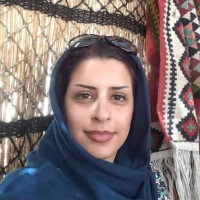Comparative Study of Repetitive Symbolic Motifs in Handwoven Fragments (Case Study of Southern Khorasan with Sistan and Baluchistan)
The region which is known in the geographical and political divisions as South Khorasan Province and Sistan and Baluchestan, have vast historical, especially cultural and artistic commonalities which is a factor in the integration and unity among the peoples of these two regions. The purpose of writing this research is to properly understand the recurring themes and their place in the art of this area, the reason and how to repeat these elements from the past to today according to the types of application of these elements in the art of the people of this place. To achieve this goal, the following questions arise: 1) Given that the creators of these designs have a separate language and culture, have there been connections between the motifs used in the handwoven fragments of these two regions and is there any similarities in their form and appearance? 2) Considering the warm and dry climate of both regions, did they use the script language to create the elements? To answer these questions, it must be stated that the most important necessity of this research was the visual analysis of these elements in accordance with their symbolic concepts. Some forms, such as plants, animals and natural objects, may be transformed into mere geometric forms or abstractions and lose their previous meaning. Today, the roles that are depicted in many arts represent specific cultural, social and individual concepts, even in their construction, the concepts and elements influenced by society and the environment in which these arts are formed. In this research, after introducing the appellation and historical background of the handwoven fragments among both regions, the introduction and classification of repetitive patterns based on the structure and apparent similarity between the motifs (geometric, vegetal, animal, vegetation) will be discussed. The present research is a comparative and analytical research and the required information is collected by library method. Indeed, by studying the obtained examples, the effects of natural, cultural and historical factors on the visual qualities of these decorations among the two regions have been examined. According to the above said, various features based on the structure and apparent similarity between geometric, animal and plant designs will be analyzed. Perhaps at first glance we can see the differences between the features of the South Khorasan and Sistan and Baluchistan handwoven objects which makes us to differentiate between them, but with some investigations we find that the apparent difference between these elements is due to the type of dialects and differences between the attitudes between these two regions’ people. Mats and handwoven fragments represent the objective crystallization of art, thought and creativity of their makers. Their designs are of great importance and value in many ways. The decoding of the designs and creative power in combining and simplifying the patterns with solid color combination is one of the important features of the handwoven things among these two regions. The common materials used in the handwoven fragments of both regions, despite relatively large intervals, indicates the presence of the various tribes in these two regions, and on the other hand is the common cultural and rich cultural base that weavers borrow from both lands; and this affinity can be clearly seen in most of the visual elements and motifs used in the rugs and Kilims of both regions. Using geometric designs such as triangle, square and diamond as the main motifs and other elements that are a combination of these original motifs, with warm colors, are balanced and dynamic compositions, symbolic using in linking designs, credibility and noteworthy wich can be found in handwoven objects of southern Khorasan and Sistan and Baluchestan. In conclusion, the present study is an analysis and comparison of repetitive patterns in the handwoven fragments, the suggestion that will be offer to the researchers is that follow this issue because this topic has a very broad scope, including colors and topics related to the color psychology and the world view that the use of these colors to decorate handwoven fragments among this tribes was originated from.
- حق عضویت دریافتی صرف حمایت از نشریات عضو و نگهداری، تکمیل و توسعه مگیران میشود.
- پرداخت حق اشتراک و دانلود مقالات اجازه بازنشر آن در سایر رسانههای چاپی و دیجیتال را به کاربر نمیدهد.



